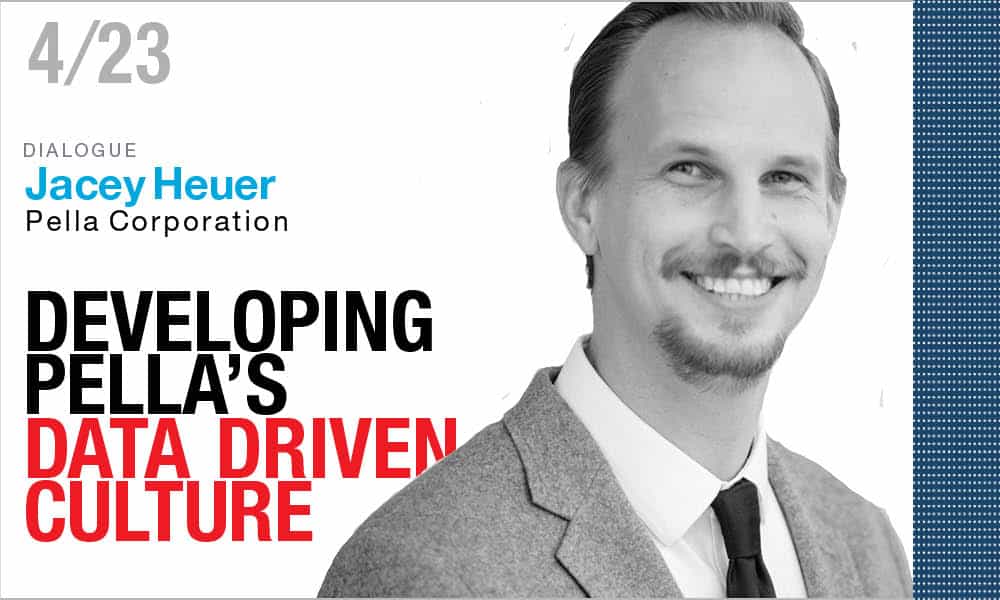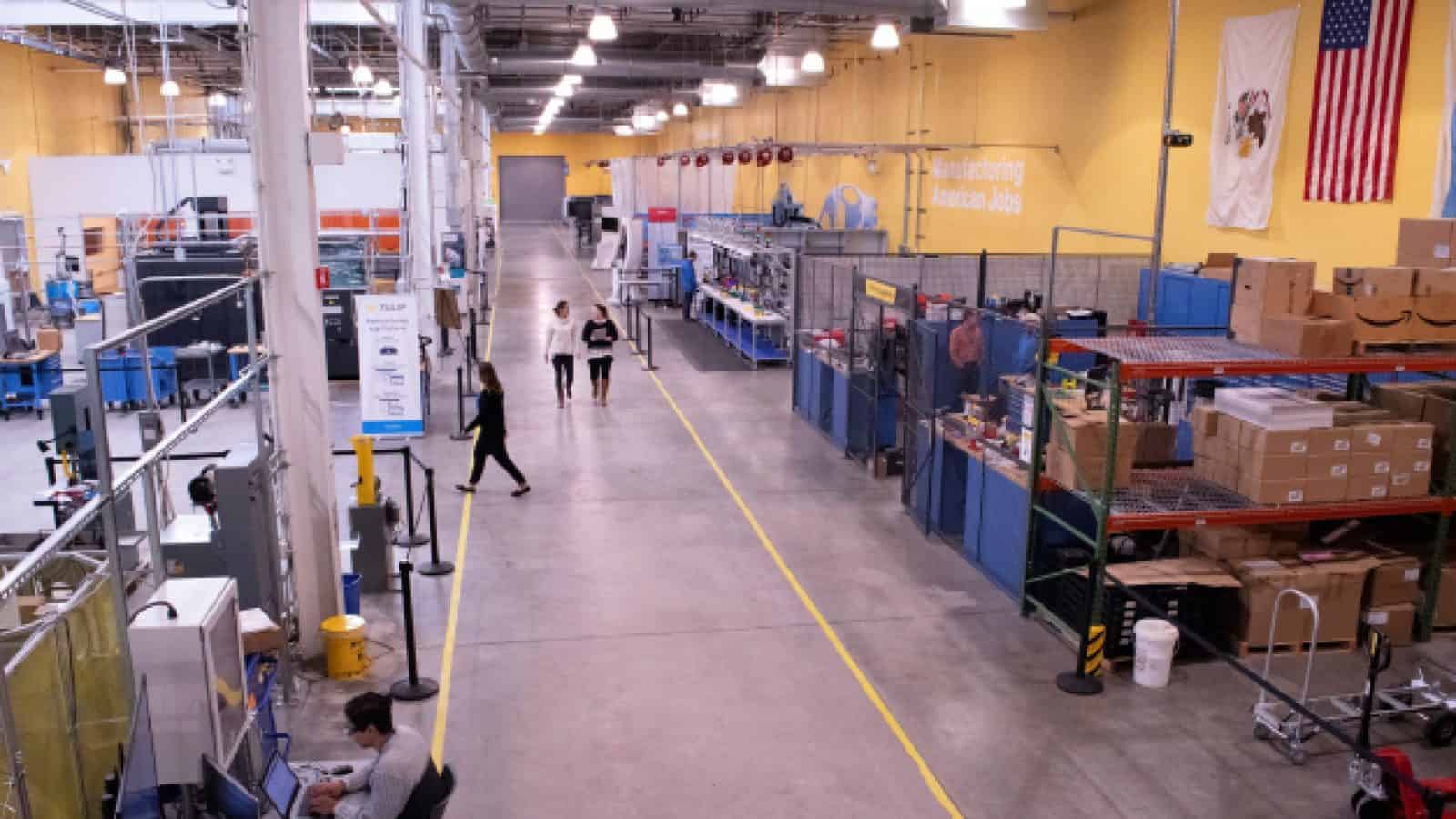Dialogue: Developing Pella’s Data Driven Culture

Creating a culture where all employees understand the importance of data to driving operational improvements and value is crucial to the future of manufacturing, believes Pella’s Head of Advanced Analytics, Jacey Heuer.

“What drives me is being part of that blank canvas and having the opportunity to create something with data analytics that is so game changing not only to Pella, but to the whole industry.”
Jacey Heuer, Head of Data Science and Advanced Analytics, Pella Corporation
Pella Corporation was founded in 1925 when lumber business owners Peter Kuyper and his wife Lucille acquired a small manufacturer of roll-up insect screens called the Rolscreen Company and moved the business to Pella, Iowa. As Pella approaches its centenary in 2025, the company has now grown into an award-winning $2 billion enterprise, with 10,000 employees, 17 manufacturing plants across the U.S., and one of the largest window and doors manufacturers in the U.S.
In our latest interview with an industry thought-leader, Pella Corporation’s Head of Data Science and Advanced Analytics, Jacey Heuer, talks to the MLC’s Executive Editor Paul Tate about transforming a mature corporation in the digital age, the need to build a solid data foundation to help reimagine traditional processes, harnessing data analytics and AI technologies to create new insights, and creating a culture of ownership where every employee understands the true value of data to improving the future of the organization.
Q: What excites you most about your role at Pella?
A: It’s the nascent nature of data and analytics in the manufacturing industry, especially in advanced data science and machine learning AI environments. Historically, there have been data and statistics and optimization initiatives in many different forms, like Six Sigma, Lean, and traditional business intelligence systems, which have been around for decades. That’s the precursor to what we’re trying to create now with the next generation of data driven solutions.
My focus is on how we accelerate to that next level of leveraging our data at Pella to drive greater economic value and greater impact across the enterprise – from customer experience and marketing, to improving the P&L and optimizing throughput capacity in manufacturing operations.

“The challenge is how do we tear the traditional processes down to introduce a new data solution that drives improvement? That’s the greatest part in all this. It’s re-imagining the way things are done.”
A lot of this stems from how we collect data. In the past, there’s been almost a taboo around adding individual transactions to data resources. Traditionally we’ve tried to eliminate that transactional data to create more efficiencies and productivity. Yet, all those transactions are data rich sources of what’s really happening as materials or products go through a facility.
This is one area where my team is now helping to change that perspective because, in a data-driven world, those transactions are valuable to us to help us continue to develop greater optimization, more insights from AI and machine learning, and better outcomes. What drives me is being part of that blank canvas and having the opportunity to create something with data analytics that is so game changing not only to Pella, but to the whole industry. There’s a lot of excitement and opportunity in that.
Q: How are Pella’s data analytics and data governance activities structured within the organization?
A: The corporate Data Analytics and Insights team, which I help to lead, is around 14 people right now and it spans core roles in data science, data analytics, data engineering, data governance, and data quality.
Our vision is a hybrid model where each plant still owns some of their data and analytics, but we at least have a governance role or advisory role in how those plants and different facilities are leveraging and using that data. I fact, we prefer to use the term data enablement, as opposed to governance, because it has a more positive connotation.
We’ve also established a corporate Data Council, and a layer of data stewards who are the front-line owners of data analytics in different facilities and are our main conduit to make sure that we’re developing and rolling out solutions in an effective manner.
The Data Council meets on a quarterly basis and includes directors and senior level leaders who provide executive sponsorship and buy-in, oversight, guidance around prioritization and what’s most important, and help steer how we drive forward. These leaders act as a megaphone for us and go down into their functions to help drive the change in mindset around data generation and use.
Further down, we also have the layer of data stewards. These are people on the frontline who may have developed a legacy system, or are in our continuous improvement environment, or in our engineering space, and are the true data owners who interact with data day-to-day. We have a roster of these data stewards, and we meet with them on a monthly basis to continue to develop a culture of data ownership and an understanding around the importance that data needs to play as move to the next generation for Pella as a data driven organization.
Q: What are the main data analytics initiatives now underway at Pella?
A: There are two key initiatives, both targeted ultimately on improving the customer experience. The first is a smart factory initiative. We have two plants that are developing different elements of a smart factory. One plant is focused more on automation, so autonomous vehicles, robotics, and those kinds of technologies. The other plant is focused more on process optimization. There’s a lot of cross-over between those, but that’s they’re starting focus.
The other key initiative is reliable delivery. We have a goal of “industry best” reliable delivery at Pella. So, we are working on how we ensure on time delivery by fully leveraging the data and applying predictive modelling using AI and machine learning technologies.

“If you don’t have a focused diligent investment into the type and frequency of the data you’re collecting, your AI and machine learning outputs are likely to struggle and perhaps fail.”
Within both of those initiatives is a focus on people, understanding individual capabilities and skills so we can optimize the role they are working on in the factory and make sure they are placed in the best position to help drive optimization.
Q: How are you integrating the data generated by legacy systems into the new analytics framework?
A: Legacy systems historically tend to be production databases where the data only exists for a short length of time before it’s purged out. We’re now applying more event-driven monitoring technologies where we can monitor each system in more detail and anytime a new event occurs, we’re taking that data out and moving it into our data lake environments to create a history of all the data. We’ve introduced technologies using application interface layers (API) that essentially provide one entry point for all those legacy systems. This helps us gain greater access to the legacy systems and move the data more easily to locations where data scientists can then work with it, or machine learning can happen, which is mostly in our cloud environment.
On top of that, from a front-end consumption standpoint, we’re developing our own internal applications so we can take the output of our AI data science models and feed it into those applications where we have more control over the user interface and experience for the people who need the information. That helps bridge that gap from the legacy to the modern, and helps develop the people, the resources, and the skills we need to make the transition occur.
Q: Once you’ve gathered all this data and analyzed it to give you new insights, how do you then operationalize those insights to drive better decisions?
A: That’s a great question. This is where the network of data stewards and the data council becomes crucial. Ultimately, they’re the people who are helping us connect with the users on the shop floor, the line managers, and the production managers, who are going to be consuming these outputs. And it’s also about how we deliver that information to the users. Think about your phone, or Facebook, or Google. There’s a whole team of individuals focused on your user experience. Historically, when you are getting a model or AI solution into production, a lot of its downfall can be because of the user experience. It can make a cool prediction, but as a user, it’s not always intuitive to use. Or there’s other reasons that might limit a person’s willingness to adopt it. We’re now leaning into that aspect of how we actively engage with our users to make sure we’re creating the right user experience so that our outputs are meeting that need. That’s helping to drive a lot of consumption and adoption.
Q: How are you harnessing AI technologies to help drive this data-driven transformation?
A: AI and machine learning are fueled by data. Like a car, or a tractor, or any big piece of machinery, it’s the fuel that makes it productive. It’s the same with AI. That data foundation is where a lot of our focus has been initially and on how we continue to influence the type of data we’re creating. I mentioned event driven technology solutions, for example. That stream of event data coming in means that we’ve now got much more clarity from when an order enters our system, to every event along its journey, to when it exits. We can see the timing and the context around that journey. We’re now able to build predictive models that are much more accurate on when an order reaches different milestones to ensure it can be delivered on time and in full to the customer. That’s an area that we’ve had a big initial impact in building predictive models that drive scheduling and the decision points along the way. On the smart factory side, for example, we’ve got a big focus on process optimization. There can be somewhere between 1,000 and 5,000 carts moving around our door facility at any time, which is where our automation focus on smart factory is happening. We’ve now applied RFID tags to the carts so we can collect passive signals as they move through the facility. We’re then leveraging that data to improve route optimization within our plants because we are able to establish see a clear linkage between the impact of delays at certain points in that process to lost units created that day. There’s clear value in that use case. The next stage is to understand how we can best scale that across our 17 plants.

“One of the key leadership skills for the future is greater trust in the individuality of all the team members, all the workforce and allowing them the freedom to create, to think, and to make decisions.”
It’s that kind of data foundation that’s going to fuel many more AI use cases for us as we go forward. Of course, understanding the intrinsic value of having a strong data foundation is something that’s not always intuitive for everyone to grasp. That’s an area where our storytelling has continued to evolve for our leadership and our plants about why investment in those technologies is going to serve us in the long-term. If you don’t have a focused diligent investment into the type and frequency of the data you’re collecting, your AI and machine learning outputs are likely to struggle and perhaps fail.
Q: What key challenges still keep you awake at night?
A: One of the core challenges is cultural. We’re trying to change the mentality so that everyone in the company has a greater understanding that every point of data, every action that someone on the shop floor or in manufacturing takes, either does, or will eventually, generate some data point that’s going to be crucial input to helping improve their lives, improve the P&L, and improve our impact as an organization as we go forward.
Another challenge, but a good challenge, is how we solve some of the technical aspects of creating a data-driven organization and re-imagine the processes that currently exist. We can develop models, develop solutions, push them to the five-yard line and are ready to hit the end zone, but then we come up against a wall of the way things have always been done. People say, “Well, this is the process”. The challenge is how do we tear that traditional process down to introduce a new data solution that drives improvement? That’s the greatest part in all this. It’s re-imagining the way things are done. In a hundred-year-old organization with a hundred years of legacy and processes in place, that’s what keeps me up at night in many ways.

“Eventually, anybody who interacts in the organization and takes an action will be able to understand how it impacts the bigger network of what’s happening.”
Q: Looking ahead, what would you highlight as the greatest challenges and opportunities for manufacturing industry as a whole for the rest of the decade?
A: I think there’s a great opportunity to create a truly connected network of data within a manufacturing organization, so that if a decision is made on one side of the business, people can see the impact that decision has way over on the other side. Eventually, anybody who interacts in the organization and takes an action will be able to understand how it impacts the bigger network of what’s happening. For example, if I make a decision to reorganize some physical part of a plant, I can see the expected impact on the other plants that are outside my immediate location. It’s a connected network of understanding, supported by a focus on the data foundation and driven by investments and front-line engagement in creating that data foundation.
Q: What key leadership skills, attributes, and roles do you feel that senior industry executives now need to lead successfully in an increasingly data-driven world?
A: One of the key leadership skills for the future is greater trust in the individuality of all the team members, all the workforce and allowing them the freedom to create, to think, and to make decisions. As people get more transparency and more understanding of the connectedness of every decision they are making, their knowledge of the true scale of impact is going to increase, so they should be able to make better informed decisions and take better informed actions. In an established legacy organization, it’s a different mindset to allow individuals that freedom and capability. From a leadership standpoint, it’s about being okay with that flexibility and that freedom.
Q: Finally, if you had to focus on one thing as a watchword or catchphrase for the future of manufacturing, what would that be?
A: It’s intelligence augmentation. I like that term because I think it captures, in those two words, the role that artificial intelligence and machine learning and data should play, and will play, in organizations in the future. It also highlights that humanity, people, are not going to go away, and that we need to ensure there’s teamwork between those people and the new technologies that will come our way. Intelligence augmentation captures that well. M

FACT FILE: Pella Corporation
HQ: Pella, Iowa
Industry Sector: Windows and Doors
Revenues: $2.17 billion
Net Income: (Privately held)
Employees: 10,000+ Employees
Presence: USA
Production Sites: 17+ Manufacturing Sites
Website: www.pella.com
EXECUTIV PROFILE: Jacey Heuer
Title: Head of Data Science and Advanced Analytics, Pella Corporation
Nationality: American
Education: BA degree, Business Administration – Finance & Economics, Wartburg College; Masters’ degree, Business Analytics and Data Analytics, Iowa State University; MBA, Iowa State University
Languages: English
Previous Roles Include:
– Data Scientist, Pella Corporation
– Data Science Author, Pluralsight
– Data Scientist, Brownells, Inc.
– Senior Pricing Strategist, MidAmercian Energy
– Assistant Vice President, Situs RERC
– Financial Analyst, The Members Group
Other Industry Roles/Awards/Board Memberships
– Golden Key International Honour Society, Iowa State University
– Iowa Technology Leadership Institute member
About the authors:

Paul Tate is Co-founding Executive Editor and Senior Content Director of the NAM’s Manufacturing Leadership Council.
